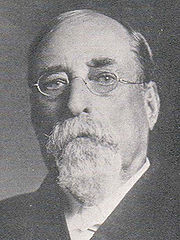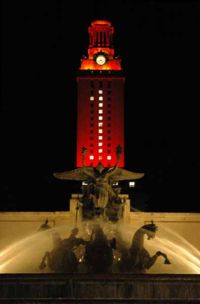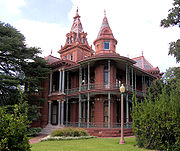
George W. Littlefield
Encyclopedia

Confederate States of America
The Confederate States of America was a government set up from 1861 to 1865 by 11 Southern slave states of the United States of America that had declared their secession from the U.S...
officer, cattleman, banker, and regent of the University of Texas
University of Texas at Austin
The University of Texas at Austin is a state research university located in Austin, Texas, USA, and is the flagship institution of the The University of Texas System. Founded in 1883, its campus is located approximately from the Texas State Capitol in Austin...
. Born in Mississippi
Mississippi
Mississippi is a U.S. state located in the Southern United States. Jackson is the state capital and largest city. The name of the state derives from the Mississippi River, which flows along its western boundary, whose name comes from the Ojibwe word misi-ziibi...
, Littlefield moved to Texas
Texas
Texas is the second largest U.S. state by both area and population, and the largest state by area in the contiguous United States.The name, based on the Caddo word "Tejas" meaning "friends" or "allies", was applied by the Spanish to the Caddo themselves and to the region of their settlement in...
with his family as a boy.
Early life
George W. Littlefield was born June 21, 1842 in Panola County, MississippiPanola County, Mississippi
-Demographics:As of the census of 2000, there were 34,274 people, 12,232 households, and 9,014 families residing in the county. The population density was 50 people per square mile . There were 13,736 housing units at an average density of 20 per square mile...
to Fleming Littlefield and Mildred Terrell Satterwhite White Littlefield. In 1850, the family moved to Texas, settling in western Gonzales County
Gonzales County, Texas
Gonzales County is a county located in the U.S. state of Texas. In 2000, its population was 18,628. It is named for its seat, the city of Gonzales.-History Timeline:* Paleo-Indians Hunter-gatherers, and later Coahuiltecan, Tonkawa, Karankawa...
near the community of Belmont.
His father died in 1853, and for one year in the late 1850s George attended Baylor University
Baylor University
Baylor University is a private, Christian university located in Waco, Texas. Founded in 1845, Baylor is accredited by the Southern Association of Colleges and Schools.-History:...
, then located in Independence
Independence, Texas
Independence is an unincorporated community in Washington County, Texas, United States. Located twelve miles northeast of Brenham, it was founded in 1835 in Austin's colony of Anglo Americans. It became a Baptist religious and educational center of the Republic of Texas...
in Washington County. By 1860, the family had moved closer to the town of Gonzales
Gonzales, Texas
Gonzales is a city in Gonzales County, Texas, United States. The population was 7,202 at the 2000 census. It is the county seat of Gonzales County.-Geography:Gonzales is located at...
, living in the fertile bottomlands at the confluence of the Guadalupe
Guadalupe River (Texas)
The Guadalupe River runs from Kerr County, Texas to San Antonio Bay on the Gulf of Mexico. The river is a popular destination for rafters and canoers. Larger cities along the river include New Braunfels, Kerrville, Seguin, Gonzales, Cuero, and Victoria...
and San Marcos
San Marcos River
The San Marcos River rises from the San Marcos Springs, the location of Aquarena Springs, in San Marcos, Texas. The springs are home to several threatened or endangered species, including the Texas Blind Salamander, Fountain Darter, and Texas Wild Rice...
rivers. At 18 years old, George was listed in the census as the manager of his mother's plantation. The real estate was valued at over $23,000 with personal property valued at $30,000. The personal estate included thirty slaves.
Military service
In 1861, Littlefield enlisted in the 8th Texas Cavalry, popularly known as Terry's Texas RangersTerry's Texas Rangers
The 8th Texas Cavalry, , popularly known as Terry's Texas Rangers, was a group of Texas volunteers for the Confederate States Army assembled by Colonel Benjamin Franklin Terry in August 1861...
. He mustered in as Second Sergeant of Company I. On January 10, 1862, he was elected 2nd Lieutenant.
He commanded the company at the Battle of Shiloh
Battle of Shiloh
The Battle of Shiloh, also known as the Battle of Pittsburg Landing, was a major battle in the Western Theater of the American Civil War, fought April 6–7, 1862, in southwestern Tennessee. A Union army under Maj. Gen. Ulysses S. Grant had moved via the Tennessee River deep into Tennessee and...
, because the Captain and 1st Lieutenant were on furlough in Texas. The Captain never returned and the 1st Lieutenant was killed a few days after returning to the regiment. Littlefield was elected Captain on May 10. There was only one man younger than he in the entire company and he was not yet 20 years old.

Battle of Perryville
The Battle of Perryville, also known as the Battle of Chaplin Hills, was fought on October 8, 1862, in the Chaplin Hills west of Perryville, Kentucky, as the culmination of the Confederate Heartland Offensive during the American Civil War. Confederate Gen. Braxton Bragg's Army of Mississippi won a...
. After the battle of Chickamauga
Battle of Chickamauga
The Battle of Chickamauga, fought September 19–20, 1863, marked the end of a Union offensive in southeastern Tennessee and northwestern Georgia called the Chickamauga Campaign...
on September 18–20, 1863, he was made acting major of the regiment. On December 26, 1863, at Mossy Creek in East Tennessee he was severely wounded and given a full promotion to major.
Littlefield was discharged from service due to his wounds and returned to Gonzales County. He was unable to walk without the assistance of crutches until 1867.
Businessman
Littlefield did not prosper immediately after the war. His attempts at farming foundered. River floods in 1869 and 1870 took him to the brink of bankruptcy. It was not until 1871 that he speculated in the cattle market and made a profit. Over the next several years, he drove large herds of beef cattle from South Texas to Kansas. Ranches he established or owned included the LIT in the Texas Panhandle; the Bosque Grande in the Pecos River Valley and the Four Lakes on the plains, both in New Mexico; the Yellow House on the Texas South Plains; and the Mill Creek and Saline in the Texas Hill Country. At one time, his cattle branded LFD roamed over an area of Eastern New Mexico the size of the state of Rhode Island.In 1883, he moved to Austin
Austin, Texas
Austin is the capital city of the U.S. state of :Texas and the seat of Travis County. Located in Central Texas on the eastern edge of the American Southwest, it is the fourth-largest city in Texas and the 14th most populous city in the United States. It was the third-fastest-growing large city in...
. He organized and served as president of the American National Bank from 1890 until 1919. The bank commonly paid an annual dividend of 20 percent to its shareholders.
Philanthropist
Littlefield was appointed to the Board of Regents of the University of Texas in 1911, and his largess to the school in the following nine years became legendary.Littlefield gave and bequeathed some $3 million to the university—more than any other individual during the first fifty years of its existence. As a result of his philanthropy, Littlefield's name is visibly entwined with many aspects of university life. In 1914 Littlefield, feeling the university's textbooks were too Northern-focused, established the "Littlefield Fund for Southern History" to amass the archival sources from which more accurate history could be written; many Southern-themed books in circulation at the university's libraries today are stamped with his name as a result. In 1917, when Governor James E. Ferguson
James E. Ferguson
James Edward "Pa" Ferguson, Jr. , was a Democratic politician from the state of Texas.- Early life :Ferguson was born to the Reverend James Ferguson, Sr., and Fannie Ferguson near Salado in south Bell County, Texas. He entered Salado College at age twelve but was eventually expelled for...
vetoed appropriations for the University in the state budget, Littlefield offered to personally fund its operations for the biennial period.
Littlefield paid for a prominent and well-recognized fountain on campus, the Littlefield Fountain
Littlefield Fountain
Littlefield Fountain is a monument by Italian-born sculptor Pompeo Coppini, located on the main campus of The University of Texas at Austin in Austin, Texas....
, which was established as a war memorial. He also bankrolled the construction of one of the university's dorms, named Alice P. Littlefield Dormitory after his wife. He stipulated that it should be used specifically for freshman women.

Littlefield House
The Littlefield House is an historic home in Austin, Texas on the campus of the University of Texas at Austin. The home was built in 1893 for Civil War veteran George Littlefield, who was a successful businessman in the bank and cattle trades and a major benefactor to UT...
to the university, which today uses it for offices and special events.
Personal life
Littlefield married Alice Payne Tillar on January 14, 1863. They had two children, both of whom died in infancy. As a result, he was very close to his extended family, paying for the college education of all of his many nieces and nephews. He also employed nephews and the husbands of nieces as managers in his many business concerns.George W. Littlefield died at his home in Austin on November 10, 1920. He is buried in Oakwood Cemetery in Austin next to his wife who survived him by fifteen years. Buried near him on the plot is his life-long servant Nathan Stokes.
Works on Littlefield include David B. Gracy II, George Washington Littlefield: A Biography in Business (Ph.D. dissertation; Texas Tech University, 1971) and J. Evetts Haley
J. Evetts Haley
James Evetts Haley, Sr., usually known as J. Evetts Haley , was a Texas-born political activist and historian who wrote multiple works on the American West, including an enduring biography of legendary cattleman Charles Goodnight...
's George W. Littlefield, Texan (1943) through the University of Oklahoma
University of Oklahoma
The University of Oklahoma is a coeducational public research university located in Norman, Oklahoma. Founded in 1890, it existed in Oklahoma Territory near Indian Territory for 17 years before the two became the state of Oklahoma. the university had 29,931 students enrolled, most located at its...
Press in Norman
Norman, Oklahoma
Norman is a city in Cleveland County, Oklahoma, United States, and is located south of downtown Oklahoma City. It is part of the Oklahoma City metropolitan area. As of the 2010 census, Norman was to have 110,925 full-time residents, making it the third-largest city in Oklahoma and the...
.
The city of Littlefield, Texas
Littlefield, Texas
Littlefield is a city in and the county seat of Lamb County, Texas, United States. The population was 6,507 at the 2000 census. It is located in a significant cotton growing region, northwest of Lubbock on the Llano Estacado just south of the beginning of the Texas Panhandle...
is named after him. He is also the namesake of the local Austin camp of the Sons of Confederate Veterans
Sons of Confederate Veterans
Sons of Confederate Veterans is an American national heritage organization with members in all fifty states and in almost a dozen countries in Europe, Australia and South America...
.

